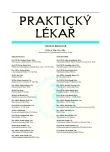Neurostimulation for the treatment of refractory angina pectoris
Authors:
P. Neužil 1; D. Urgošík 2; M. Táborský 1
Authors‘ workplace:
Kardiologické oddělení Kardiocentra
Primář: doc. MUDr. Miloš Táborský, CSc., FESC, MBA
1; Oddělení stereotaktické a radiační neurochirurgie Neurocentra
Primář: doc. MUDr. Roman Liščák, CSc.
Nemocnice Na Homolce
Ředitel: MUDr. Vladimír Dbalý, MBA
2
Published in:
Prakt. Lék. 2009; 89(2): 85-88
Category:
Of different specialties
Overview
Background:
Neurostimulation as a symptomatic treatment of refractory angina pectoris (AP) is one of only a few methods (along with laser revascularization) that can be used to improve the quality of life of patients with this debilitating disease. Patients with advanced stages of AP (III-IV. CCSC classification) are indicated for this treatment when neither open-heart surgery nor percutaneous revascularization (PCI) improves the symptoms in concert with maximal drug treatment.
Method:
In this review we describe the method of spinal cord stimulation (SCS), covering the experience with this method in the Czech Republic as well as abroad. This treatment is concentrated in pain syndrome treatment centres and is notable for its interdisciplinary cooperation. The procedure itself is carried out by an anaesthetist or neurosurgeon with the assistance of a cardiologist who is also responsible for the follow-up care using a programme which allows communication with and programming of the neurostimulator device that is implanted into the patient. The other part of the review discusses the mechanisms of the positive influence of stimulation including a potential placebo effect, b endorphins stimulation, decrease of nociceptive inputs, „homogenization“ of the myocardial perfusion, decrease of the effect of adenosine; nevertheless the basic concept is based on direct stimulation of low-threshold A fibres, which conduct pain-less impulses. SCS attenuates sensitivity of high-threshold thin C fibres, which are responsible for conducting the painful impulse through the spino-thalamic pathway, which is diminished by the effect of SCS.
Conclusion:
Our own experience and results published in the international literature clearly document, in a highly selected patient group, that this symptomatic treatment, particularly for very active individuals, helps to relieve attacks of pain and improves patient quality of life.
Key words:
Refractory angina pectoris, neuromodulation, spinal cord stimulation
Sources
1. Murphy, D.F., Giles, K.E. Dorsal column stimulation for pain relief from intractable angina pectoris. Pain 1987, 28, p. 365-368.
2. Mannheimer, C., Carlsson, C.A., Emanuelsson, H. et al. The effects of transcutaneous electrical nerve stimulation in patients with severe angina pectoris. Circulation 1985, 71, p. 308-316.
3. De Jongste, M.J.L., Haaksma, J., Hautvast, R.W.M. et al. Effects of spinal cord stimulation on myocardial ischaemia during daily life in patients with severe coronary artery disease. A prospective ambulatory electrocardiographic study. Br. Heart J. 1994, 71, p. 413-418.
4. Murray, S., Carson, K.G.S., Ewings, P.D. et al. Spinal cord stimulation (SCS) significantly decreases the need for acute hospitalization due to chest pain in patients with refractory angina pectoris. Heart 1999, 82, p. 89-92.
5. Sanderson, J.E. Ibrahim, B., Waterhouse, D. et al. Spinal electrical stimulation for intractable angina - long term clinical outcome and safety. Eur. Heart J. 1994, 15, p. 810-814.
6. Andersen, C., Hole, P., Oxhoj, H. Does pain relief with spinal cord stimulation for angina conceal myocardial infarction? Br. Heart J. 1994, 71, p. 413-418.
7. Shealey, C.N., Mortimer, J.T., Reswick, J.B. Electrical inhibition of pain by stimulation of the dorsal columns. Anesth. Analg. 1967, 46, p. 45-47.
8. Jacobs, M.J., Jorning, P.J., Joshi, S.R. et al. Epidural spinal cord electrical stimulation improves microvaskcular blood flow in severe limb ischaemia. Ann. Surg. 1988, 207, p. 170-183.
9. Mannheimer, C., Augustinsson, L.E., Carlsson, C.A. et al. Epidural SCS in severe angina pectoris. Br. Heart J. 1988, 59, p. 56-61.
10. Norrsell, H., Eliasson, T., Manheimer, C. et al. Effect of pacing-induced myocardial stress and spinal cord stimulation on whole body norepinephrine spillover. Eur. Heart J. 1997, 18, p. 1890-1896.
11. Hautvast, R.W.M., Blanksma, P.K., De Jongste, M.J.L. et al. Effect of spinal cord stimulation on myocardial blood flow assessed by positron emission tomography in patients with refractory angina perctoris. Am. J. Cardiol. 1996, 77, p. 462-467.
12. Eliasson, T., Mannheimer, C., Waagstein, F. et al. Safety aspects of spinal cord stimulation in severe angina pectoris. Cor. Art. Dis. 1994, 5, p. 333-339.
13. Mannheimer, C., Eliasson, T., Andersson, B. et al. Effects of spinal cord stimulation in angina pectoris induced by pacing and possible mechanisms of action. Br. Heart J. 1993, 301, p. 477-480.
14. Greco, C. Spinal cord stimulation for the treatment of refractory angina pectoris: a two year follow up. PACE 1999, 22, p. 26-32.
15. Mannheimer, C., Eliason, T., Augustinsson, L.E. et al. Electrical stimulation versus coronary artery bypass surgery in severe angina pectoris: the ESBY study. Circulation 1998, 97, p. 1157-1163.
16. Hautvast, R.W.M., De Jongste, M.J.L., Stal, M.J. et al. Spinal cord stimulation in intractractable angina pectoris: A randomized controlled efficacy study. Am. Heart J. 1998, 136, p. 1114-1120.
17. Sanderson, J.E., Brooksby, P., Waterhause, D. et al. Epidural spinal electrical stimulationfor severe angina: a study of its effect on symptoms, exercise tolerance and degree of ischaemia. Eur. Heart J. 1992; 13: p. 628-633.
18. Ten Vaarwerk, I.A.M., Jessurum, G.A.J., De Jongste, M.J.L. et al. Clinical outcome of patients treated with spinal cord stimulation for therapeutically refractory angina pectoris. Heart 1999, 82, p. 82-88.
19. Murray, S., Carson, K.G., Ewings, P.D. et al. Spinal cord stimulation significantly decreases the need for acute hospital admission for chest pain in patients with refractory angina pectoris. Heart 1999, 82, p. 89–92.
Labels
General practitioner for children and adolescents General practitioner for adultsArticle was published in
General Practitioner

2009 Issue 2
Most read in this issue
- Hand transplantation
- Post-traumatic stress disorder in abused children
- Allergic rhinitis as an occupational disease
- Patient satisfaction with provided care: theoretic approaches and models
